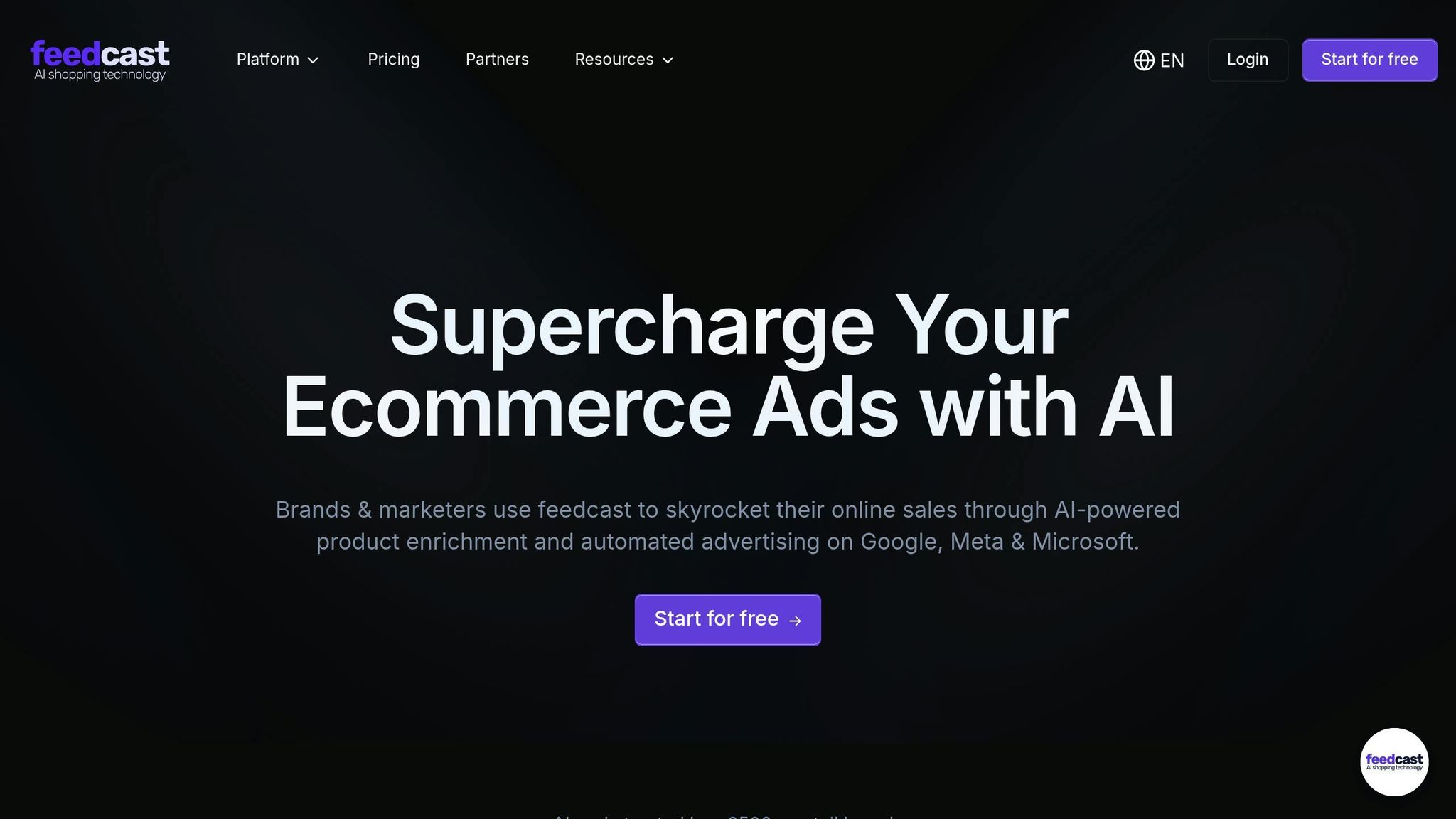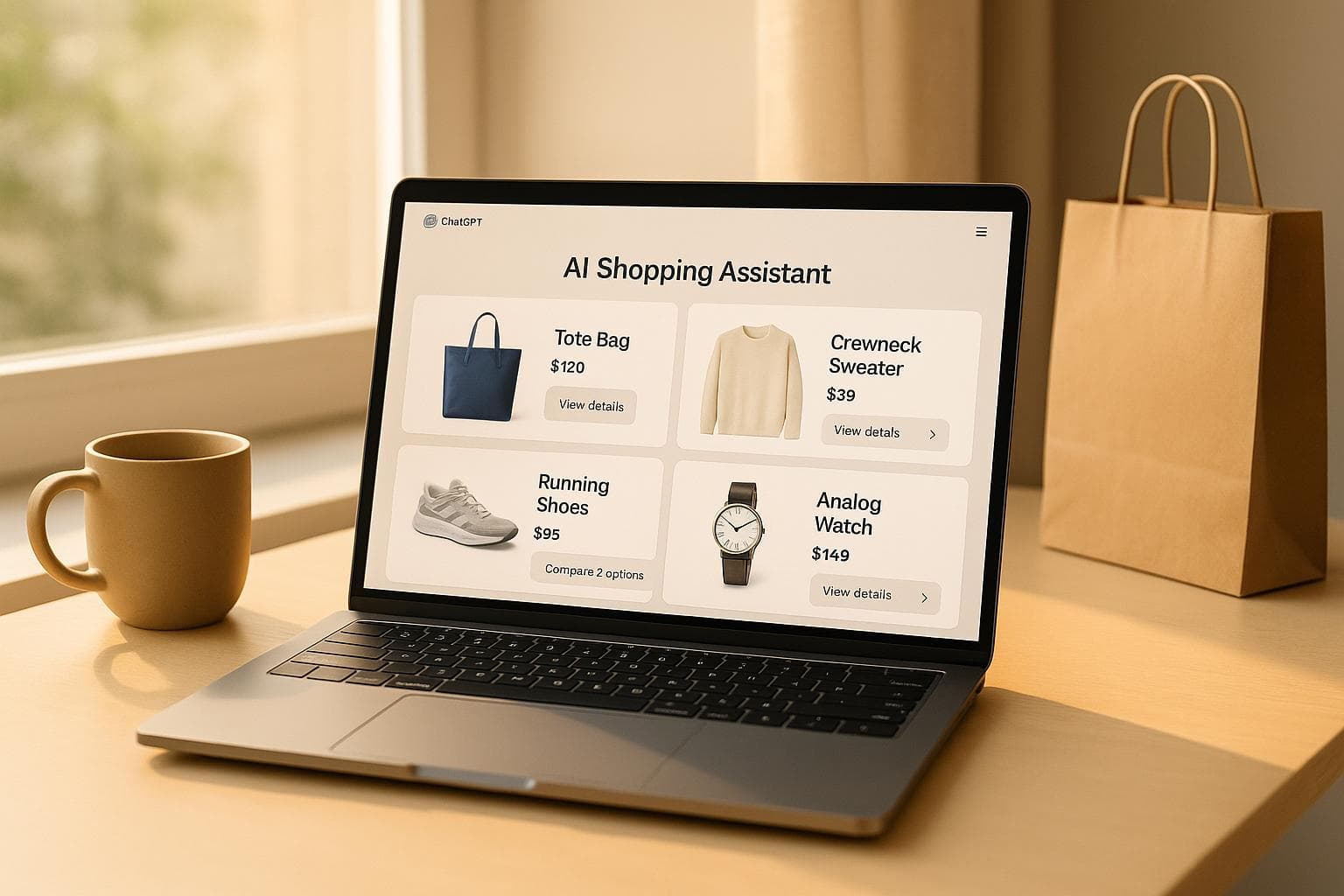How AI Personalizes Visuals for Seasonal Ads
Explore how AI revolutionizes seasonal advertising by personalizing visuals for different audiences, enhancing engagement and efficiency.
AI is transforming seasonal advertising by creating tailored visuals that resonate with specific audience segments. Instead of generic ads, businesses can now produce hundreds of variations quickly, thanks to generative AI. This approach uses customer data, seasonal trends, and brand guidelines to design visuals that appeal to different demographics, shopping habits, and even device preferences. Here’s what makes it work:
- Generative AI: Creates new visuals from scratch, analyzing customer behavior and seasonal patterns to produce designs that align with audience preferences.
- Personalization: Ads reflect audience traits like shopping habits, location, and timing, ensuring relevance during short seasonal windows.
- Dynamic Design: Modular components like backgrounds, text, and images are automatically combined to produce multiple ad versions.
- Real-Time Optimization: AI adjusts visuals based on performance data, keeping campaigns effective as trends shift.
- Privacy Considerations: AI balances personalization with data protection, using anonymized data and respecting user consent.
These tools help businesses stand out in competitive seasons like Black Friday or Christmas, driving higher engagement and conversions while saving time and resources. Tools like Feedcast.ai further simplify managing seasonal campaigns, offering centralized dashboards and automated updates for ad visuals and product data.
Cadbury: The Art of AI and Personalization in Marketing

Core Features of AI-Driven Visual Personalization
AI-driven tools are reshaping seasonal advertising by combining in-depth audience insights, flexible design systems, and strict adherence to brand standards. Together, these elements create seasonal ads that feel personalized and professional, delivering the right message to the right audience at just the right time.
Using Audience Data to Customize Visuals
AI doesn’t just scratch the surface with basic demographics like age or location. It digs deeper, analyzing factors like shopping habits, device preferences, purchase history, and browsing patterns to tailor visuals for specific audience segments.
Take a winter coat campaign, for example. AI might identify that outdoor enthusiasts are drawn to images showcasing rugged mountain landscapes and technical fabric details. Meanwhile, urban professionals might respond better to sleek cityscapes paired with messaging focused on style and versatility. Based on these insights, the system automatically selects the most fitting imagery, color palettes, and layouts for each group.
Even the devices people use influence the visuals. Mobile users tend to prefer bold, straightforward designs, while desktop users can handle more intricate layouts and detailed imagery. AI adjusts elements like image size, text placement, and overall composition to suit each platform.
Timing also plays a major role. AI analyzes when different audience groups are most likely to engage with seasonal campaigns. Early holiday shoppers might see ads emphasizing "limited-time offers" or "shop early to beat the rush", while last-minute shoppers are served visuals focused on "fast shipping" or "still time to order" messaging.
Armed with this data, AI doesn’t just stop at insights - it uses them to build visuals through a modular design system.
Dynamic Modular Design for Scalability
AI employs a modular design approach, treating visual elements like interchangeable building blocks. Backgrounds, product images, text overlays, logos, and seasonal accents are all modular components that can be mixed and matched automatically to create countless ad variations.
This system is a game-changer for seasonal campaigns. Instead of designing each ad manually, AI can generate hundreds or even thousands of variations while maintaining professional quality. For instance, a holiday campaign might use a set of modular elements that can be reconfigured for Halloween, then quickly adapted for Black Friday, all while staying true to the brand’s identity.
Flexibility is key here. AI can easily adjust modular components to fit new themes or seasonal demands, ensuring campaigns stay relevant even as the calendar changes. Back-to-school visuals can seamlessly transform into Halloween designs, and then shift again for winter holidays - all without starting from scratch.
What’s more, AI learns from performance data. If certain color schemes or layouts resonate better with specific audiences, the system prioritizes those combinations in future campaigns. This creates a feedback loop, where each iteration becomes smarter and more effective.
To keep everything polished, AI enforces strict design rules. It ensures text remains readable against backgrounds, logos are properly spaced, and seasonal elements don’t overshadow the product. These automated checks ensure every ad variation meets professional standards.
Adding Brand Guidelines and Seasonal Elements
AI doesn’t just assemble ads - it ensures every piece reflects the brand’s identity while incorporating seasonal themes. Brand colors, fonts, logo placement, and style are treated as non-negotiable. Even when introducing seasonal shades like Halloween orange or Christmas red, the core brand colors stay front and center.
Seasonal elements go beyond generic holiday decorations. AI understands the nuances of American holidays and shopping habits. For example, Fourth of July campaigns might highlight patriotic themes alongside summer products, while back-to-school ads focus on preparation and fresh starts.
Regional differences also come into play. A spring campaign in the Northeast might emphasize the excitement of “finally warm weather,” while the same campaign in Southern California could lean into the idea of “perfect weather all year.” AI ensures these seasonal elements are tailored to resonate with diverse audiences, creating inclusive campaigns that connect without alienating any group.
Timing is everything when it comes to seasonal themes. AI knows when to introduce and retire specific elements. Halloween visuals might appear in early October but vanish after the 31st, while winter themes can extend into February, depending on the product and audience location. This timing intelligence ensures campaigns stay relevant and impactful throughout the season.
Real-Time Campaign Optimization
AI uses real-time performance data to fine-tune seasonal visuals, ensuring campaigns stay effective throughout the season. By adapting to shifts in consumer behavior and market trends as they happen, AI keeps campaigns aligned with current demands.
Dynamic Creative Optimization in Action
Dynamic Creative Optimization (DCO) demonstrates how AI can elevate seasonal advertising. By testing multiple visual variations simultaneously, AI identifies which elements drive the most engagement and conversions, then shifts budgets toward those high-performing visuals.
For example, AI delivers different visuals to similar audience segments, tracking metrics like click-through rates, conversion rates, and cost per acquisition. It experiments with elements such as backgrounds, product placement, and text, prioritizing those that resonate most with audiences. In a winter clothing campaign, AI might find that action shots of people wearing the products outperform static images, prompting it to focus on those dynamic visuals.
The speed of AI-driven optimization is particularly valuable during seasonal campaigns. Traditional testing methods often require weeks to gather enough data for reliable insights, but AI can make fast, data-backed adjustments during high-traffic periods, maximizing impact when it matters most.
AI also detects creative fatigue. If an ad that initially performed well begins to lose engagement, the system can automatically introduce refreshed visuals or updated seasonal elements to maintain audience interest and keep campaigns feeling new.
By continuously testing and adapting, AI ensures visuals stay relevant, even as seasonal trends and market conditions evolve.
Responding to Seasonal Trends and Performance Data
AI goes beyond testing by aligning ad visuals with external seasonal factors. Weather changes, social media chatter, news events, and market dynamics all play a role in how AI optimizes visuals.
Take weather patterns, for instance. During an unseasonably warm winter, AI might shift focus away from heavy coats to lighter clothing or indoor holiday items. Conversely, a sudden cold snap could lead to increased promotion of warm accessories and outerwear.
AI also monitors social media sentiment and broader trends to keep campaigns timely. For example, during Earth Day, AI might emphasize eco-friendly product features, while back-to-school campaigns could highlight cost-saving options.
Historical data from past seasons adds another layer of precision. By analyzing previous performance trends, AI can proactively adjust visual strategies, ensuring campaigns are informed by lessons from earlier seasons.
Cross-channel insights further refine AI's decisions. Different platforms often favor distinct visual styles - lifestyle imagery might perform better on one channel, while another may respond to product-centric visuals. AI tailors campaigns accordingly, offering detailed product overlays in email campaigns while using bold, eye-catching designs for display ads.
AI doesn’t just chase short-term performance. It balances immediate results with long-term brand consistency, ensuring that seasonal campaigns remain aligned with broader business objectives. The result? Campaigns that evolve intelligently, staying relevant and effective as consumer preferences and market conditions shift in real time.
sbb-itb-0bd1697
Audience Targeting and Data Privacy
AI is changing the game for seasonal campaigns, helping brands connect with the right audiences through behavioral patterns and contextual signals. These tools allow for highly targeted visual experiences. But this level of precision comes with a challenge: balancing personalization with privacy, especially as data regulations tighten across the United States.
Audience Segmentation for Seasonal Campaigns
AI excels at identifying audience segments by analyzing factors like browsing habits, purchase history, geographic location, and seasonal activity. This allows brands to create visuals tailored to the unique needs and preferences of different groups during seasonal events.
Geographic and climate-based segmentation: AI adapts visuals to reflect regional weather, local holidays, and other location-specific preferences. For example, a campaign might feature cozy sweaters for colder regions while showcasing lightweight jackets for warmer climates during the same season.
Behavioral segmentation: AI examines how users engage with seasonal content. It distinguishes early holiday shoppers starting in October, last-minute buyers in December, and bargain hunters focused on sales events. These insights enable brands to deliver visuals that align with each group’s shopping habits.
Intent-based targeting: By analyzing search queries and website interactions, AI determines where users are in their shopping journey. For instance, someone searching for "best winter coats for kids" might see product-focused visuals, while another user looking up "winter coat size 8 blue" receives tailored options. Early-stage researchers might encounter lifestyle content to inspire their purchase.
Cross-seasonal insights: AI uses past data to anticipate future behavior. A customer who bought outdoor gear last spring might see camping promotions as summer approaches, while someone who purchased holiday home décor last year could receive early access to new seasonal collections.
Micro-moments targeting: AI pinpoints the best moments to deliver seasonal messages, ensuring campaigns hit at just the right time for maximum impact.
While these techniques make campaigns more precise and engaging, they also demand rigorous privacy measures.
Privacy and Data Use in Personalization
With detailed segmentation comes the responsibility to protect user privacy. AI-driven personalization must strike a careful balance between effective targeting and safeguarding individual data.
Data minimization: AI systems focus on behavioral patterns and contextual signals rather than personal details. Instead of collecting sensitive information, they analyze broader trends like browsing habits, seasonal engagement, and demographic categories to guide targeting.
Consent management: Users are given clear choices about how their data is used. If someone opts to share minimal information, AI shifts to relying on contextual signals - such as time of day, general location, or seasonal trends - rather than personal browsing history.
Anonymization and aggregation: AI systems work with anonymized data sets, identifying patterns at scale without linking them to individual users. This protects privacy while still enabling effective personalization.
Transparency in targeting: Brands that explain why users see specific visuals build trust. AI systems now provide clearer insights into how user preferences shape the content they encounter, fostering greater engagement.
Cross-platform privacy coordination: As users move between platforms - email, social media, or display ads - AI ensures their privacy settings and consent choices remain consistent. This unified approach respects user preferences across all touchpoints.
To maintain this balance, brands are adopting privacy-by-design principles, conducting regular compliance checks, and offering user-friendly tools that allow individuals to control how their data is used. These practices ensure that personalization remains effective without compromising trust.
Seasonal campaigns that prioritize both personalization and privacy show that it’s possible to deliver relevant, timely visuals while protecting user data. This approach not only drives engagement and conversions but also strengthens trust in the long run.
Managing Seasonal Ad Campaigns with Feedcast.ai

Running seasonal ad campaigns across multiple platforms can be a daunting task, but Feedcast.ai simplifies the process with its AI-driven tools that handle the heavy lifting.
AI-Powered Product Feed Enrichment
Feedcast.ai takes product feed management to the next level by leveraging AI to create seasonally relevant content. Instead of sticking to generic product data, the platform transforms it to better connect with shoppers during key seasons. For example, a simple title like "Men's Jacket" is upgraded to "Waterproof Winter Jacket – Perfect for Cold Weather Adventures", aligning with a winter campaign. It also fixes common feed issues, such as missing images or incomplete descriptions, ensuring your ads are polished and ready to perform on all platforms.
Unified Dashboard for Campaign Management
With Feedcast.ai’s centralized dashboard, businesses can manage campaigns across platforms like Google, Facebook, Instagram, and Microsoft Ads from one place. This unified view allows real-time monitoring of performance, making it easier to adjust strategies on the fly.
Seasonal Campaigns for U.S. Businesses
For e-commerce businesses in the U.S., seasonal campaigns come with unique challenges. Feedcast.ai addresses these hurdles by automating updates to product details and visuals, freeing up teams to focus on bigger-picture strategies. Refined product data and precise targeting help make the most of seasonal ad budgets, driving better returns. Additionally, the ability to manage custom labels allows brands to group products based on seasonal rules, while performance analytics highlight top-performing items and reveal areas for improvement [1]. This streamlined approach enables businesses to deliver more tailored and impactful seasonal campaigns.
Conclusion
Our deep dive into AI-driven personalization highlights its undeniable impact on seasonal advertising strategies. A study involving over 21,000 consumers revealed that AI-generated personalized video ads deliver 6–9 percentage points higher engagement compared to both personalized image ads and generic video ads. Even more impressive, these ads achieve this while slashing production costs by nearly 90% [3]. These findings align with the efficiency gains seen in real-time campaign optimizations.
The cost-effectiveness and efficiency of AI personalization make it accessible for businesses of all sizes. Automated AI systems dramatically shorten production timelines, turning weeks of work into mere hours. This allows marketers to test multiple creative ideas quickly and pivot campaigns in response to evolving seasonal trends.
For U.S. e-commerce businesses, tools like Feedcast.ai simplify the complexities of managing seasonal campaigns. With a centralized dashboard, marketers can oversee platforms like Google, Facebook, Instagram, and Microsoft Ads in one place. AI-powered product feed enrichment ensures seasonal messaging stays engaging, while automated updates to product details and visuals save time. This shift allows marketing teams to focus on strategy rather than manual tasks.
AI also scales personalization in ways that were previously unimaginable. By enabling thousands of tailored ad variations for specific audience segments, locations, and seasonal contexts, businesses can see improved conversion rates and ROI across all advertising channels.
Looking ahead, generative AI is advancing rapidly, introducing features like emotion-aware and adaptive ads that respond in real time to user behavior and seasonal changes [2][4]. These innovations are pushing beyond basic templates to create dynamic, engaging experiences that resonate deeply with audiences.
FAQs
How does AI make seasonal ads more relevant for different audiences and regions?
AI improves the impact of seasonal ads by analyzing real-time data, audience behavior, and preferences to craft visuals and messages that align with specific regions. It factors in local traditions, trends, and seasonal habits, ensuring the content connects with different audience groups on a deeper level.
Through dynamic customization, AI fine-tunes ad visuals and messaging to match regional tastes, holidays, and cultural practices. This level of personalization not only enhances engagement but also ensures the ads feel timely and relatable, making seasonal campaigns far more effective.
How does AI ensure personalized seasonal ads respect user privacy?
AI makes it possible to create personalized seasonal ads while respecting user privacy. It does this through methods like data anonymization and consent-based data collection, which safeguard personal information yet still allow marketers to reach their intended audience effectively.
Another common approach is contextual targeting. Instead of relying on personally identifiable information (PII), this technique analyzes non-personal data, such as browsing behavior or general trends. By focusing on privacy-first strategies, AI ensures that seasonal ads remain relevant and engaging without compromising consumer trust.
How does AI improve seasonal ad performance in real time?
AI takes seasonal ad performance to the next level by analyzing campaign data in real-time and tweaking key elements like bids, audience targeting, and creative assets on the fly. This keeps your ads relevant and effective, especially during high-demand times.
By continuously fine-tuning these factors, AI helps boost engagement, improve return on investment (ROI), and cut down on wasted ad spend. This real-time responsiveness ensures your campaigns stay competitive and deliver results throughout the season.
Geoffrey G.










